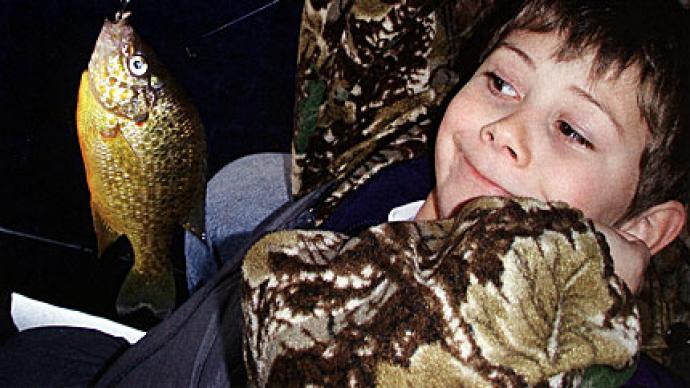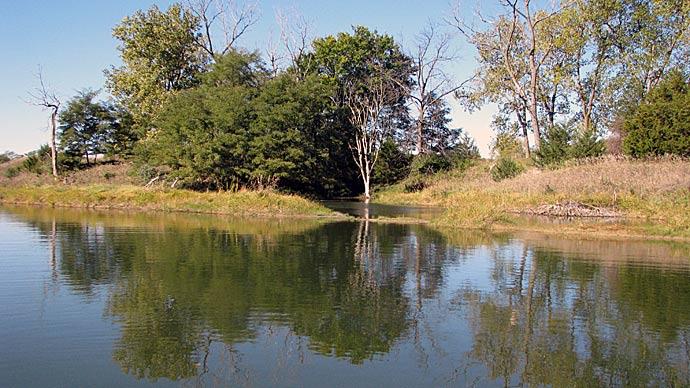
Spring is an amazing time. Escaping the throes of winter, what little winter we had in north Texas, watching plants change, nourished back from dormancy as temperatures rise and spring rains bring much needed water, enjoying wildlife as they prepare for another year of living, growing, having babies and doing what wild creatures do.
Each spring I know bass start their spawning rituals and ease up on readied beds when the first trees bud. Crater-shaped nests are swept clean, to a rocky base, by daddy bass, ready when momma is ready.
Spring is an exciting period of anticipation. Along with that anticipation I always feel a bit of anxiety. My mind reels with questions. Answers follow, and it seems as though things always work out for the best on my ranch. You may have some of the same questions. How did the bass and bluegill survive dormant winter months? Are threadfin shad still alive? We had two hard cold snaps, shortlived as they were, and immediately after the last one I saw hundreds of tiny dead threadfin shad lining the shoreline in shallow water, their lifeless silver bodies prostrate, bobbing with ebbing waves. It makes my stomach ache and a bit of that dreaded anxiety flutters through my head. Threadfin shad die when water temperatures fall to 42 degrees, you know. Perhaps a few lived ... did they? Soon, I'll know.
What is my management plan for the year? How will changes in water chemistry and clarity change my plan over last year? With a flood in August and a drought during the rest of the last three years, water levels and chemistry have seen dramatic fluctuations. A pond is a living, breathing being, always evolving. Last year's plan may not be the same as next years. Should I stock more threadfin shad? Are there baby bluegill, yet? What shape are the bass in? Those giant channel catfish we caught last fall ... did they gorge on dead shad, enough to make it difficult to see those consequences? Do I harvest fish? Catch and release?
Some of those questions were answered last Saturday.
It was one of those perfect spring days that rarely fall on the weekend; I anxiously waited for the sun to rise high enough in the eastern sky to warm waters on the south end and shallow coves of the nine acre lake. The water temperature can vary as much as 5 degrees in shallow areas by noon. This time of year those upper, shallow reaches are the hotspots for big bass!
Heavy casting rod and spinner bait in hand I quietly slipped the boat into the lake and made my way south. First cast, nothing. Then the second, WHAM, a red tailed male smacked the spinnerbait as it descended in murky water. Within seconds, he was at the side of the boat. Hah, just as hoped, a rough looking daddy, in the middle of the spawn. That's a good sign. I immediately measured and weighed the fish and checked his condition, 16 inches and larger than two pounds, no obvious signs of maladies, good shoulders on him, color and smell were right in line. Perfect, back in the water he went. This is a pretty large, young male for this lake, so I chose to release him. I grabbed my shore log book and wrote quick notes. Good records are important. Back to the same spot, next cast BOOM, another red tailed male came to the boat, similar to the first fish, just a bit smaller. A cull fish. This one went in the basket for three reasons..one, I wanted to check the stomach contents and see what he had eaten..two, fresh fried bass sounded great for dinner..and three, the lake has plenty of males, so no adverse affect to the spawn. Down the shore I flogged, for the next five hours. I landed fish after fish, an amazing forty bass in all, six large, young females, each tipping the scales beyond five pounds. Their tummies were rotund, egg laden, looking like they were ready to burst.
As the afternoon wore on, bass began to chase shad in the shallows, knocking them up on the bank while gorging themselves on the silvery feasts. Thank goodness the cold didn't kill all the shad, and what a show to see from a boat. As the frenzy reached its crescendo, a belted kingfisher dove into the act. As bass pushed and herded shad the kingfisher would hover just above, timing his next meal as bass pushed shad shoreward. He hovered, dove, and rose as fast as he fell, each time with a squiggling shad in his beak. The shorebound shad didn't stand a chance. Awesome.
I kept a total of six fish, all ragged males between 1.5 and 2.5 pounds. As I filleted bass, my mind absorbed the fantastic afternoon of fishing, while trying to digest information the fish had bestowed on me.
The stomach of each fish was full of shad. One feisty bass had shad and one small turtle. Where was my camera, when I needed it? I caught one 10 inch fish and everything else was 15 inches or larger. The 10 inch bass appeared to be a runt from last years surviving spawn, so I surgically removed his fillets. Fish were extremely healthy and age groups were spread fairly evenly. So, what to do for the upcoming year?
With good answers to several questions to several important questions, my management thinking is shifting. Yes, threadfin shad survived over winter. Largemouth bass are in excellent shape to start the spring. The lake doesn't need shad, and culling bass doesn't appear to be a critical issue.
More answers are needed. Next weekend, we'll try some bluegill fishing, to inspect sizes and numbers. If the water is warm enough, we might even make a few shoreline seine pulls with a short, fine mesh seine and see if there are any baby bluegill, yet.
Lastly, there is a fair amount of dormant coontail, a plant which could become an issue. Coontail has a tendency to invade small lakes like mine and can take too much water.
While now, in early spring, there's not much to do other than maintain what we have in the lake, watching and being aware is the most important task. My lake enters its sixth season in great shape. Early planning, paying attention to the habitat, then the fishery has really paid off. With the lake record bass now larger than eight pounds, I expect a double digit bass any time now.
In the meantime, it's enjoy time. Enjoy the lake, watch when the feeder goes off and tosses it little golden nuggets into the water, and ensuing frenzy of bluegill and catfish.
As the dock, lawn chair, nice temperatures and cool spring time beverage beckon, all I can think of is that old southern saying, "If it ain't broke, don't fix it."
Reprinted with permission from Pond Boss Magazine



